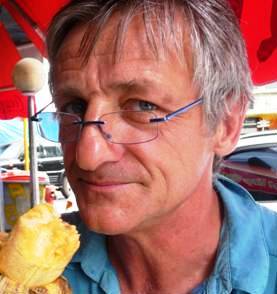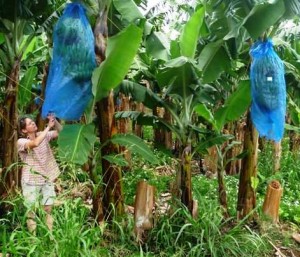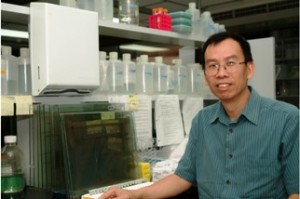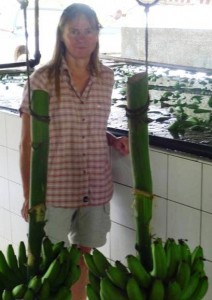Getting to the core of a world-favourite dessert by unravelling banana’s origin and genealogy
GCP has enabled us to lay a credible foundation, which gave us a leg-up in the intense competition that typifies the genome sequencing arena” – Angélique D’Hont, CIRAD researcher
An ‘A’ to our banana team for ushering in a new era in banana genetics. But let soup precede dessert, and don’t let this worry you: stay with us because we’re still very much on the topic and focused on bananas, which offer the whole range from soup and starters, to main course and dessert, plus everything else in between, being central for the food security of more than 400 million people in the tropics: around a third each is produced in Africa, Asia-Pacific and Latin America, and the Caribbean. About 87 percent of all the bananas produced worldwide are grown by small-scale farmers.
Moving back then to soup for starters, we’re serving up our own unique blend of alphanumeric banana ‘soup’, spiced with ABCs, a pinch of 123s, plus a dash of alpha and omega. Curious about the ABCs? Look no further:‘C’ for getting to the core of ‘B’ for bananas, and an ‘A’ score for our ace genomics team that did it.
Read how GCP seeded … and succeeded, in helping open a new era in banana genetics. An achievement by itself, and an important milestone on the road to unlocking genetic diversity for the resource-poor, which is GCP’s raison d’être.
So get your travelling gear please, for time travel with a ‘midspace checkpoint’ in Malaysia.
We start in 2004, when GCP commissioned a survey of diversity with microsatellites (or SSRs, simple sequence repeats) for all mandate food crops in the CGIAR crop research Centres. The objective of that study was to make new genetic diversity from genebank accessions available to breeders.
The endpoint is opening new research avenues to incorporate genes for disease resistance, with the added bonus of an article published in Nature online on July 11 2012, entitled The banana (Musa acuminata) genome and the evolution of monocotyledonous plants.
It may not be quite as easy as the ABC and 123 that The Jacksons promise in song, but we promise you that the science is just as exciting, with practical implications for breeding hardy disease-resistant bananas. Onwards then to the first leg of this three-step journey!
(Prefer a shorter version of this story in pictures? We’ve got it! Choose your medium between Flickr and Facebook)
1) Let’s go Greek: the alpha and omega of it
Rewinding to the beginning

The proof of the pudding is in the eating: we imagine that Jean Christophe Glaszmann just has to be saying “Yummy!” as he samples this banana.
Start point, 2004: “At that time, several research groups had developed SSR markers for bananas, but there was no coordination and only sketchy germplasm studies,” recalls Jean Christophe Glaszmann (pictured), then the leader of what was GCP’s Subprogramme 1 (SP1) on Genetic Diversity on a joint appointment with CIRAD. He stepped down as SP1 Leader in March 2010, and is currently the Director of a multi-institutional research unit Genetic improvement and adaptation of Mediterranean and tropical plants (AGAP, by its French acronym) at France’s Centre de ccoopération internationale en recherche agronomique pour le développement (CIRAD) in Montpellier.
Jean Christophe continues, “The reference studies had been conducted with RFLP* markers, a very useful tool but far too cumbersome for undertaking large surveys. We mobilised Bioversity International, CIRAD and the International Institute of Tropical Agriculture for the project. The process took time, but delivered critical products.” [*RFLP stands for restriction fragmented length polymorphism]
Fastforward to 2012, and gets just a little geeky…
Eight years down the road in 2012, the list of achievements is impressive, as evidenced by a suite of published papers which provide the details of the analysis of SSR diversity and describe how the data enabled the researchers to unravel the origin and genealogy of the most important dessert bananas. The origin of the predominant variety – Cavendish – suggested by the markers, involves two rounds of spontaneous hybridisation between three markedly differentiated subspecies. This scheme has been marvellously corroborated by linguistic patterns found in banana variety names as revealed in a paper published in 2011 in the proceedings of USA’s National Academy of Sciences.
But what else happened in between the start- and end-point? We now get to the really ‘sweet’ part of this bonanza for banana breeding!
It is now possible to conduct research to identify and incorporate genes for disease resistance within fertile populations that are close to the early progenitors, and then inter-cross them to re-establish sterility and obtain vigorous, disease-resistant and seedless progenies.
2) Of bits, bananas, breeding and breadcrumbs
Threading all these bits together for breeding better bananas is akin to following a trail of breadcrumbs, in which GCP played an important facilitating role: where in the germplasm to undertake genetic recombination is one key; and then, how to expedite incorporation of disease resistance and how to control sterility – so as to first suppress it, then re-establish it – is another set of keys that are necessary for proficient breeding.
In 2005, Hei Leung (pictured), then Leader of GCP’s Subprogramme 2 on Comparative Genomics (until June 2007) on a dual appointment with the International Rice Research Institute (IRRI), recognised that with GCP’s main focus being drought tolerance in crops, Musa (the banana and plantain botanical genus) was somewhat on the fringe. However, it was still important that GCP support the emergence of banana genomics.
Hei is currently Programme Leader of Genetic Diversity and Gene Discovery at IRRI. He remembers, “We had a highly motivated group of researchers willing to devote their efforts to Musa. Nicolas Roux at Bioversity was a passionate advocate for the partnership. The GCP community could offer a framework for novel interactions among banana-related actors and players working on other crops, such as rice. The team led by Takuji Sasaki of Japan’s National Institute of Agrobiological Science, which had vast experience in rice genome sequencing, added the scientific power. So, living up to its name as a Challenge Programme, GCP decided to take the gamble on banana genomics and help it fly.”
Through several projects, GCP helped consolidate Musa genomic resources, contributed to the establishment of medium-throughput DArT markers as well as the construction of the first saturated genetic map. Additional contributions included the first round of sequencing of large chromosome segments (BAC clones) and its comparison with the rice sequence and a detailed analysis of resistance gene analogues. All these findings have now been published in peer-reviewed journals. And while publication takes time, it still remains a high-premium benchmark for quality and validation of results, and for efficient sharing of information. It reinforces the value of collaboration, builds capacity and gives visibility to all partners, thereby providing potential new avenues for funding.
Such was the case with bananas: using a collaborative partnership framework established with the Global Musa Genomics Consortium, animated by Nicolas Roux and now chaired by Chris Town, the community developed a case for sequencing the genome. With the mentorship of Francis Quétier, contacts were made with various major players in genomics, which in the end formalised a project between France’s CIRAD and CEA–Genoscope, funded by the Agence Nationale de la Recherche and led by Angélique D’Hont (pictured) and Patrick Wincker.
GCP contributed DArT analysis for anchoring the sequence to the genetic map. But, as stressed by Angélique, CIRAD researcher and lead author of the Nature paper: “Above all, GCP has enabled us to lay a credible foundation, which gave us a leg-up in the intense competition that typifies the genome sequencing arena. We were delighted that France rolled the dice in our favour by funding this work.”
3) Musa musings on the road to and from Malaysia checkpoint
Three years down the road, the team published a description of the genome of a wild banana from Malaysia.

Jean Christophe communes with a Musa plant, perhaps musing “What’s your family history and when will you be fully grown?”
Let’s drill down to some technical facts and figures here: the Musa genome has some 520 million nucleotides distributed across 11 chromosomes, revealing traces of past duplications and bearing some 36,000 genes. While most genes derived from duplication tend to lose their function, some develop novel functions that are essential for evolution; bananas seem to have an outstanding range of transcription factors that could be involved in fruit maturity.
And while the road ahead remains long, we now have a good understanding of banana’s genetic diversity, we have genomic templates for functional studies (a whole-gene repertoire) as well as for structural studies (the chromosome arrangement in one subspecies) aimed at unraveling the genomic translocations that could control sterility in the species complex.
It is now possible to conduct research to identify and incorporate genes for disease resistance within fertile populations that are close to the early progenitors, and then inter-cross them to re-establish sterility and obtain vigorous, disease-resistant and seedless progenies.
This is undoubtedly an inspiring challenge towards unlocking the genetic diversity in this crop, which is central to food security for more than 400 million people in the tropics.
Links
- OPEN ACCESS BOOK CHAPTER: How to phenotype bananas and plantains for drought
- Comparative and applied genomics
- Comparative Genomics Research Initiative (maize, rice and sorghum)
- Browse for Musa resources by keying in a search for ‘Musa’ on the GCP Product Catalogue
- Journal articles from GCP research projects
- SEE IT IN PICTURES & CHOOSE YOUR MEDIUM! Photo-story version on both Flickr and Facebook










